2023 TOYOTA 86 charging
[x] Cancel search: chargingPage 311 of 449
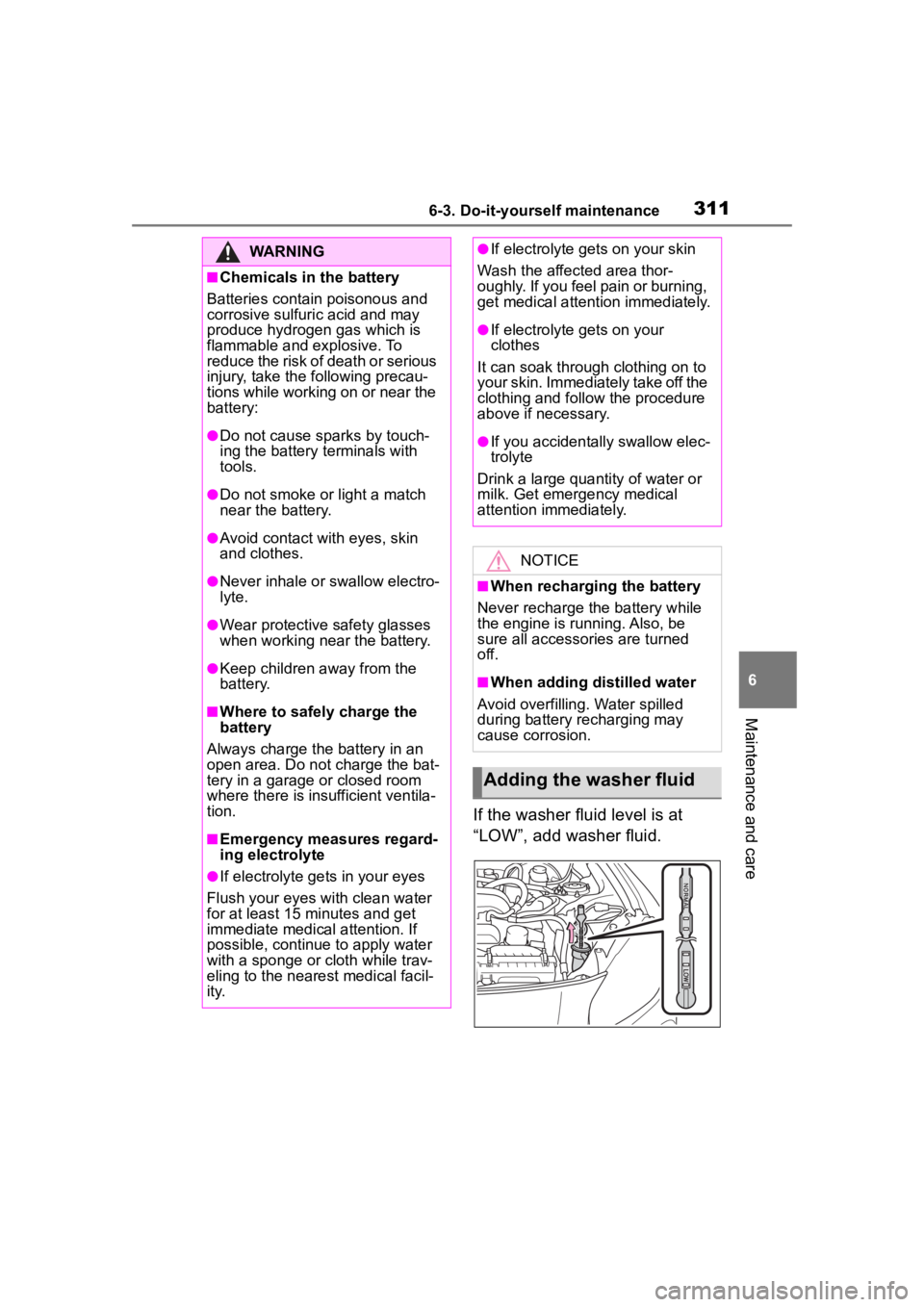
3116-3. Do-it-yourself maintenance
6
Maintenance and care
If the washer fluid level is at
“LOW”, add washer fluid.
WARNING
■Chemicals in the battery
Batteries contai n poisonous and
corrosive sulfuric acid and may
produce hydrogen gas which is
flammable and explosive. To
reduce the risk of death or serious
injury, take the following precau-
tions while working on or near the
battery:
●Do not cause sparks by touch-
ing the battery terminals with
tools.
●Do not smoke or light a match
near the battery.
●Avoid contact with eyes, skin
and clothes.
●Never inhale or swallow electro-
lyte.
●Wear protective safety glasses
when working near the battery.
●Keep children away from the
battery.
■Where to safely charge the
battery
Always charge the battery in an
open area. Do not charge the bat-
tery in a garage or closed room
where there is insufficient ventila-
tion.
■Emergency measures regard-
ing electrolyte
●If electrolyte gets in your eyes
Flush your eyes with clean water
for at least 15 minutes and get
immediate medical attention. If
possible, continue to apply water
with a sponge or cloth while trav-
eling to the nearest medical facil-
ity.
●If electrolyte gets on your skin
Wash the affected area thor-
oughly. If you feel pain or burning,
get medical attention immediately.
●If electrolyte gets on your
clothes
It can soak through clothing on to
your skin. Immediately take off the
clothing and follow the procedure
above if necessary.
●If you accidentally swallow elec-
trolyte
Drink a large quantity of water or
milk. Get emergency medical
attention immediately.
NOTICE
■When recharging the battery
Never recharge the battery while
the engine is running. Also, be
sure all accessories are turned
off.
■When adding distilled water
Avoid overfilling. Water spilled
during battery recharging may
cause corrosion.
Adding the washer fluid
Page 348 of 449
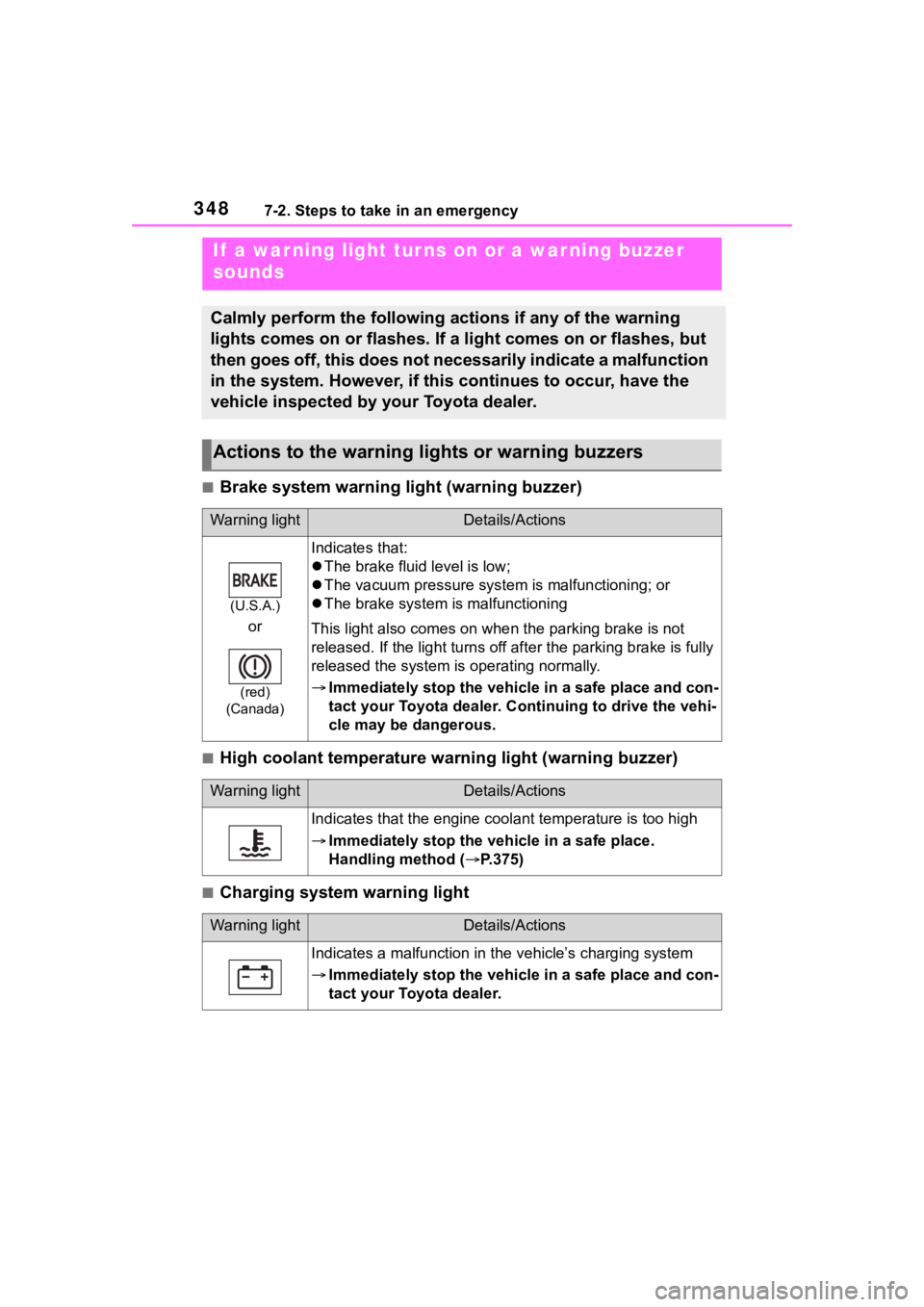
3487-2. Steps to take in an emergency
■Brake system warning light (warning buzzer)
■High coolant temperature warning light (warning buzzer)
■Charging system warning light
If a war ning light tur ns on or a war ning buzzer
sounds
Calmly perform the following actions if any of the warning
lights comes on or flashes. If a light comes on or flashes, but
then goes off, this does not necessarily indicate a malfunction
in the system. However, if this continues to occur, have the
vehicle inspected by your Toyota dealer.
Actions to the warning lights or warning buzzers
Warning lightDetails/Actions
(U.S.A.)
or
(red)
(Canada)
Indicates that:
The brake fluid level is low;
The vacuum press ure system is malfunctioning; or
The brake system is malfunctioning
This light also comes on whe n the parking brake is not
released. If the light turns off after the parking brake is ful ly
released the system is operating normally.
Immediately stop the vehicle in a safe place and con-
tact your Toyota dealer. Continuing to drive the vehi-
cle may be dangerous.
Warning lightDetails/Actions
Indicates that the engine coolant temperature is too high
Immediately stop the vehicle in a safe place.
Handling method ( P.375)
Warning lightDetails/Actions
Indicates a malfunction in the vehicle’s charging system
Immediately stop the vehicle in a safe place and con-
tact your Toyota dealer.
Page 373 of 449
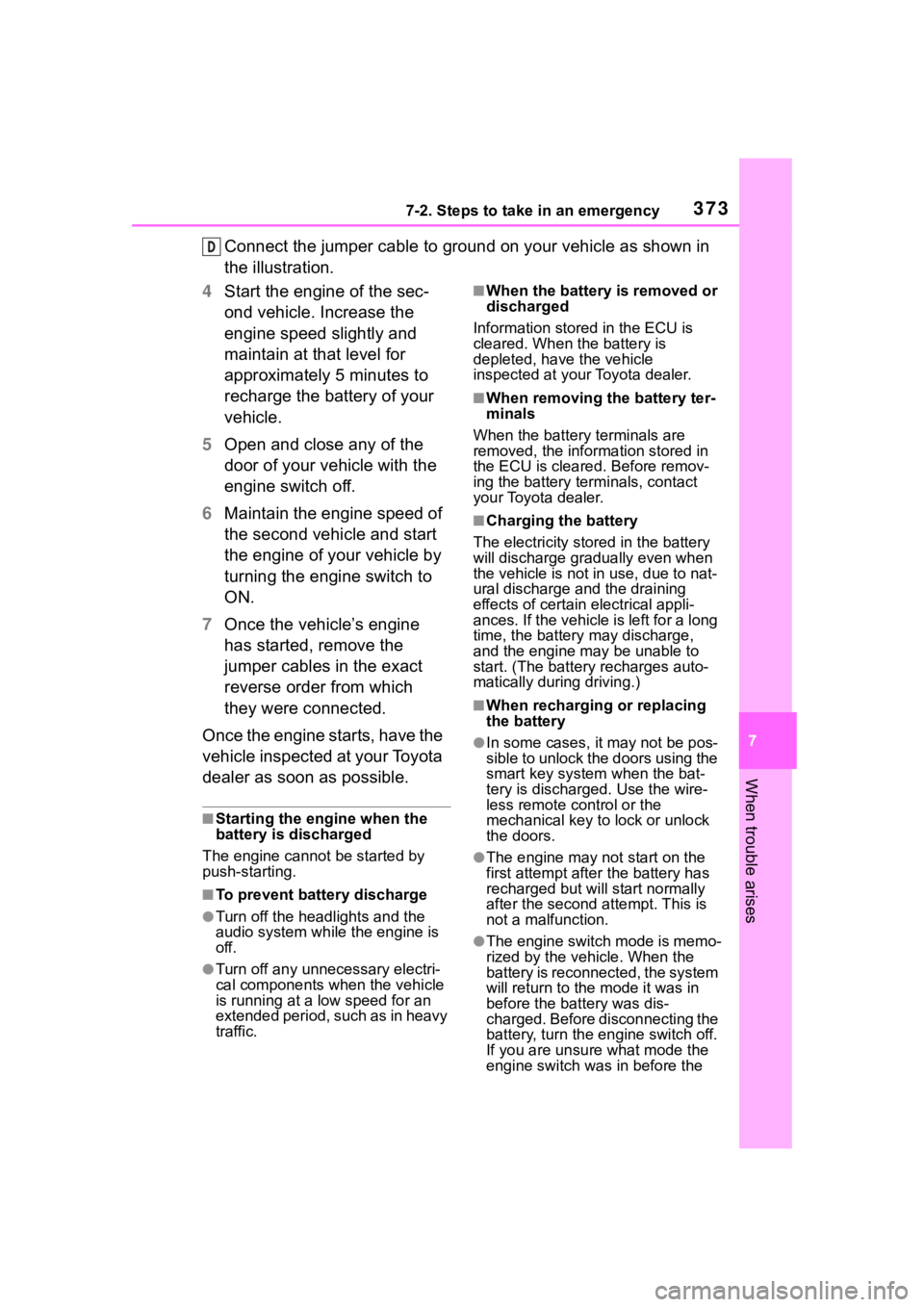
3737-2. Steps to take in an emergency
7
When trouble arises
Connect the jumper cable to ground on your vehicle as shown in
the illustration.
4 Start the engine of the sec-
ond vehicle. Increase the
engine speed slightly and
maintain at that level for
approximately 5 minutes to
recharge the battery of your
vehicle.
5 Open and close any of the
door of your vehicle with the
engine switch off.
6 Maintain the engine speed of
the second vehicle and start
the engine of your vehicle by
turning the engine switch to
ON.
7 Once the vehicle’s engine
has started, remove the
jumper cables in the exact
reverse order from which
they were connected.
Once the engine starts, have the
vehicle inspected at your Toyota
dealer as soon as possible.
■Starting the engine when the
battery is discharged
The engine cannot be started by
push-starting.
■To prevent battery discharge
●Turn off the headlights and the
audio system while the engine is
off.
●Turn off any unnecessary electri-
cal components when the vehicle
is running at a low speed for an
extended period, such as in heavy
traffic.
■When the battery is removed or
discharged
Information stored in the ECU is
cleared. When the battery is
depleted, have the vehicle
inspected at your Toyota dealer.
■When removing the battery ter-
minals
When the battery terminals are
removed, the information stored in
the ECU is cleared. Before remov-
ing the battery term inals, contact
your Toyota dealer.
■Charging the battery
The electricity stored in the battery
will discharge grad ually even when
the vehicle is not in use, due to nat-
ural discharge and the draining
effects of certain electrical appli-
ances. If the vehicle is left for a long
time, the battery may discharge,
and the engine may be unable to
start. (The battery recharges auto-
matically during driving.)
■When recharging or replacing
the battery
●In some cases, it may not be pos-
sible to unlock the doors using the
smart key system when the bat-
tery is discharged. Use the wire-
less remote control or the
mechanical key to lock or unlock
the doors.
●The engine may not start on the
first attempt after the battery has
recharged but will start normally
after the second attempt. This is
not a malfunction.
●The engine switch mode is memo-
rized by the vehicle. When the
battery is reconnected, the system
will return to the mode it was in
before the bat tery was dis-
charged. Before disconnecting the
battery, turn the engine switch off.
If you are unsure what mode the
engine switch wa s in before the
D
Page 384 of 449
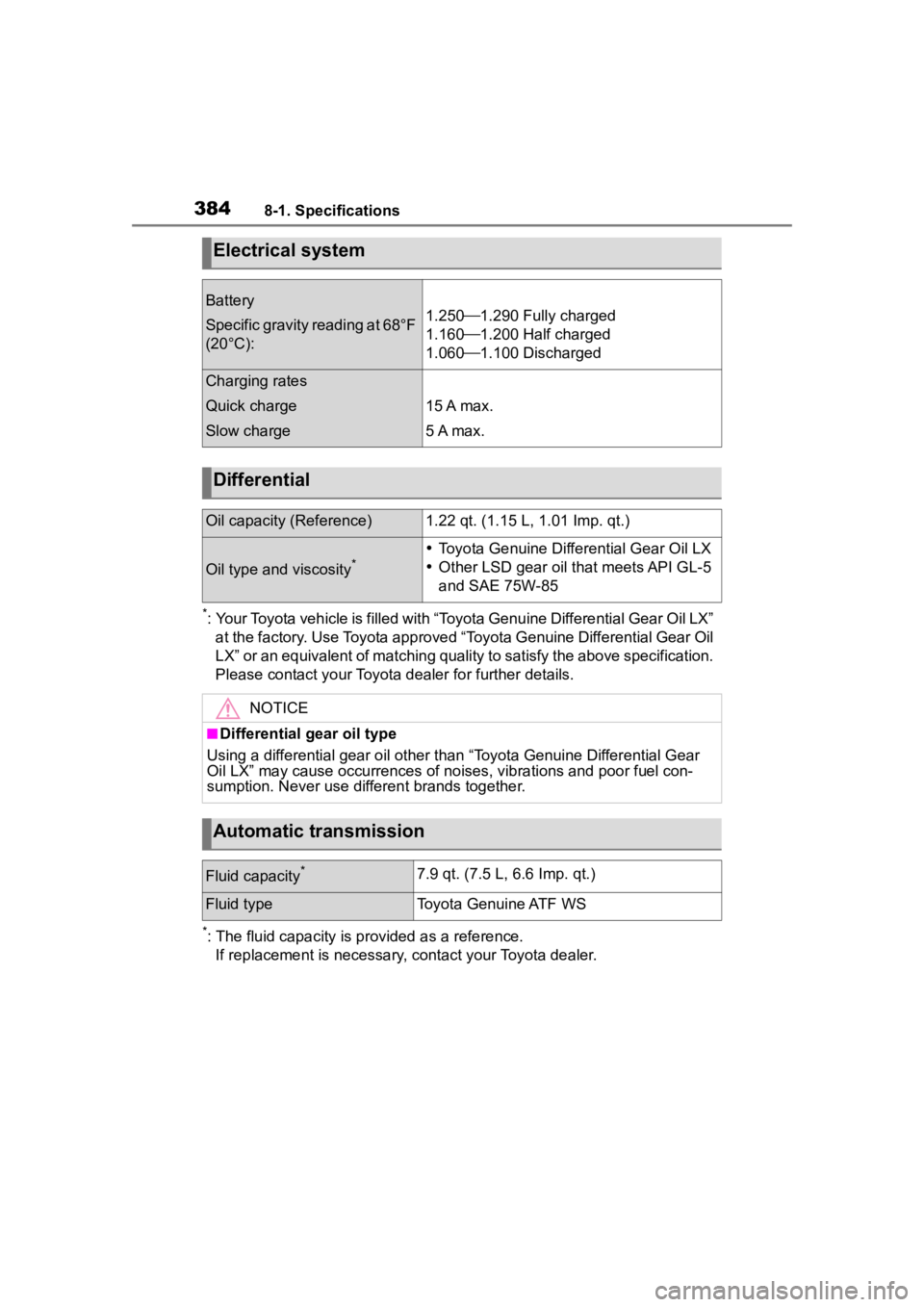
3848-1. Specifications
*: Your Toyota vehicle is filled with “Toyota Genuine Differential Gear Oil LX”
at the factory. Use Toyota approved “Toyota Genuine Differentia l Gear Oil
LX” or an equivalent of matching quality to satisfy the above s pecification.
Please contact your Toyota dealer for further details.
*: The fluid capacity is p rovided as a reference.
If replacement is necessary, contact your Toyota dealer.
Electrical system
Battery
Specific gravity reading at 68°F
(20°C):1.2501.290 Fully charged
1.1601.200 Half charged
1.0601.100 Discharged
Charging rates
Quick charge
Slow charge
15 A max.
5 A max.
Differential
Oil capacity (Reference)1.22 qt. (1.15 L, 1.01 Imp. qt.)
Oil type and viscosity* Toyota Genuine Differential Gear Oil LX
Other LSD gear oil that meets API GL-5
and SAE 75W-85
NOTICE
■Differential gear oil type
Using a differential gear oil ot her than “Toyota Genuine Differ ential Gear
Oil LX” may cause occurrences of noises, vibrations and poor fuel con-
sumption. Never use different brands together.
Automatic transmission
Fluid capacity*7.9 qt. (7.5 L, 6.6 Imp. qt.)
Fluid typeToyota Genuine ATF WS
Page 437 of 449
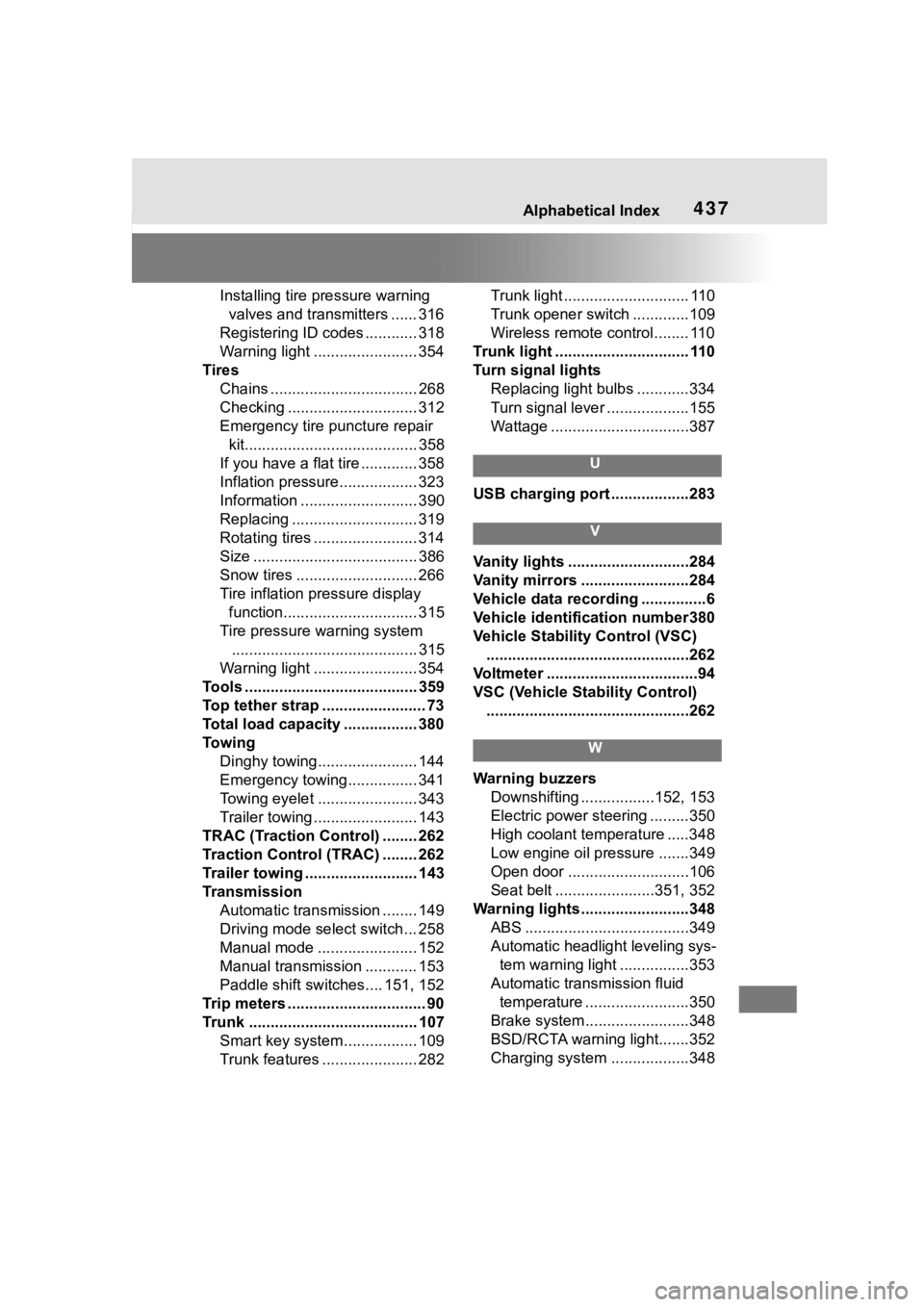
437Alphabetical Index
Installing tire pressure warning valves and transmitters ...... 316
Registering ID codes ............ 318
Warning light ........................ 354
Tires Chains .................................. 268
Checking .............................. 312
Emergency tire puncture repair kit........................................ 358
If you have a flat tire ............. 358
Inflation pressure.................. 323
Information ........................... 390
Replacing ............................. 319
Rotating tires ........................ 314
Size ...................................... 386
Snow tires ............................ 266
Tire inflation pressure display function............................... 315
Tire pressure warning system ........................................... 315
Warning light ........................ 354
Tools ........................................ 359
Top tether strap ........................ 73
Total load capacity ................. 380
To w i n g Dinghy towing....................... 144
Emergency towing................ 341
Towing eyelet ....................... 343
Trailer towing ........................ 143
TRAC (Traction Control) ........ 262
Traction Control (TRAC) ........ 262
Trailer towing .......................... 143
Transmission Automatic transmission ........ 149
Driving mode select switch... 258
Manual mode ....................... 152
Manual transmission ............ 153
Paddle shift switches.... 151, 152
Trip meters ................................ 90
Trunk ....................................... 107 Smart key system................. 109
Trunk features ...................... 282 Trunk light ............................. 110
Trunk opener switch .............109
Wireless remote control........ 110
Trunk light ............................... 110
Turn signal lights Replacing light bulbs ............334
Turn signal lever ...................155
Wattage ................................387
U
USB charging port ..................283
V
Vanity lights ............................284
Vanity mirrors .........................284
Vehicle data recording ...............6
Vehicle identification number380
Vehicle Stability Control (VSC)...............................................262
Voltmeter ...................................94
VSC (Vehicle Stability Control) ...............................................262
W
Warning buzzers Downshifting .................152, 153
Electric power steering .........350
High coolant temperature .....348
Low engine oil pressure .......349
Open door ............................106
Seat belt .......................351, 352
Warning lights .........................348 ABS ......................................349
Automatic headlight leveling sys-tem warning light ................353
Automatic transmission fluid temperature ........................350
Brake system ........................348
BSD/RCTA warning light.......352
Charging system ..................348